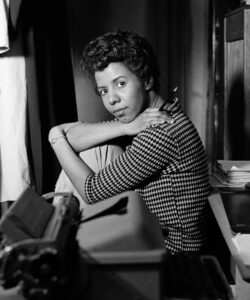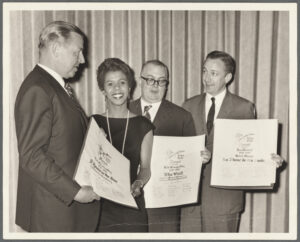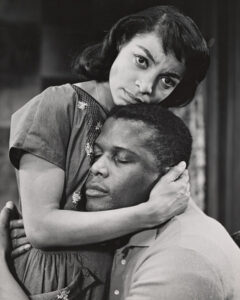A Raisin in the Sun. A world where an age-old play reveals timeless truths.
Lorraine Vivian Hansberry. A visionary. The extraordinary author behind A Raisin in the Sun draws attention to the lives of African Americans residing in Chicago who face racial segregation. The title A Raisin in the Sun was taken from the poem “Harlem” by Langston Hughes: “What happens to a dream deferred? Does it dry up like a raisin in the sun?” This play put Hansberry on the map. She became the first African American and youngest playwright to win the New York Drama Critics’ Circle Award. Not only did she win many awa rds, have many nominations, and be acknowledged for her wonderful work but she also became the first African-American female playwright/author to have a play performed on Broadway.
rds, have many nominations, and be acknowledged for her wonderful work but she also became the first African-American female playwright/author to have a play performed on Broadway.
This wonderful show needs an even more wonderful director. Luckily, Amisha Groce, the director, is leading this team with such grace and pride. Amisha got to touch on working with a timeless piece along with the impact of the play.
With a playwright as strong as Hansberry, how did you approach the challenge of bringing Lorraine Hansberry’s vision to life on stage? “Delicately. I chose to respect Ms. Hansberry’s intentions while infusing my interpretation and allowing space for the actors to do the same.” This play was an expression of Hansberry’s real life and real experiences. Groce has beautifully kept her truths and intentions as intended but with the expression of the actors interpretation. As a show that has such impact and power, what drew you to direct A Raisin in the Sun, and how do you relate to the play’s themes? “I am drawn to works that tell the stories of those whose voices tend to be muffled or altogether muted. Ms. Lorraine Hansberry’s work not only tells the story but does so beautifully. The play’s overarching theme anchored in the poem, A Dream Differed by Langston Hughes, is what resonates most with me. If we are afraid to face and conquer our deepest fears, we risk the fates of drying up, sagging, crusting over and yes, we might even explode.” A Raisin in the Sun looks at issues of family dynamics, racial identity, poverty, and pursuing one’s aspirations. It is a potent critique of the social and financial hardships African American families of that time endured.
whose voices tend to be muffled or altogether muted. Ms. Lorraine Hansberry’s work not only tells the story but does so beautifully. The play’s overarching theme anchored in the poem, A Dream Differed by Langston Hughes, is what resonates most with me. If we are afraid to face and conquer our deepest fears, we risk the fates of drying up, sagging, crusting over and yes, we might even explode.” A Raisin in the Sun looks at issues of family dynamics, racial identity, poverty, and pursuing one’s aspirations. It is a potent critique of the social and financial hardships African American families of that time endured.
A Raisin in the Sun has many moments that came difficult to direct or figure out, but as the director in your view, what’s the most powerful line or moment in the play, and how did you bring it to life in your production? “One of the most powerful moments in the play was giving Mama her gifts. It is only one of two moments in the play when the entire family experiences an outward expression of joy simultaneously. There had to be singing, teasing, smiling and of course, a little dancing amidst the mini celebration.” The directing style has a big role in creating this story and of course creating a personal connection to the play is pivotal, to you what role do you think hope plays in the story, and how did you reflect that through your direction? “Hope is the action’s sidekick in the play. The Youngers had to move their hopes and dreams out of deferment. They also had to let some of those hopes and dreams die so that the most important ones could be birthed. Throughout the play there is lots of coming and going, movement, life. Still moments are few and far between since stagnation could bring about hope’s death.”
The characters throughout this play have a personal connection to the author herself, Lorraine Hansberry as she drew from personal experiences. Groce was asked, how did you make sure the characters’ dreams  and disappointments came through clearly on stage? “As a cast and creative team, we discussed the importance of making their thinking visible through authentic staging layered with clear intentions and the texture of life.” Throughout this process, which character’s personal journey did you find most complex, and how did you highlight that in the show? “Though she exists on the perimeter of most scenes, Ruth is ever present. She counsels, shows patience, gives grace and is the glue that holds everyone else together while struggling to give herself the same courtesy until late in the second act. She is the strength that Mama cries out for; the feminist Beneatha refers to; the negotiator Walter wants to lobby on his behalf. This is not surprising lest we forget this is a play written by an African American woman.” Ruth Younger is the resilient heart of her family. She navigates the challenges of their cramped Chicago apartment with grace and practicality. Her unwavering love and determination help guide her family through tough times. As the characters battle different challenges throughout the play that Hansberry has described, how did you approach the portrayal of the family’s financial challenges and what impact that had on their relationships? “Ms. Hansberry made that part of my job very easy. The Youngers’ clothes and home were to be clean and presentable. No one was to go hungry. Everyone worked. They offered what they had to whomever came through their door. Ms. Hanberry further made it clear that lack did not equal lazy or less than and highlighted how perseverating on money could be their familial demise. Not much for me to do there.”
and disappointments came through clearly on stage? “As a cast and creative team, we discussed the importance of making their thinking visible through authentic staging layered with clear intentions and the texture of life.” Throughout this process, which character’s personal journey did you find most complex, and how did you highlight that in the show? “Though she exists on the perimeter of most scenes, Ruth is ever present. She counsels, shows patience, gives grace and is the glue that holds everyone else together while struggling to give herself the same courtesy until late in the second act. She is the strength that Mama cries out for; the feminist Beneatha refers to; the negotiator Walter wants to lobby on his behalf. This is not surprising lest we forget this is a play written by an African American woman.” Ruth Younger is the resilient heart of her family. She navigates the challenges of their cramped Chicago apartment with grace and practicality. Her unwavering love and determination help guide her family through tough times. As the characters battle different challenges throughout the play that Hansberry has described, how did you approach the portrayal of the family’s financial challenges and what impact that had on their relationships? “Ms. Hansberry made that part of my job very easy. The Youngers’ clothes and home were to be clean and presentable. No one was to go hungry. Everyone worked. They offered what they had to whomever came through their door. Ms. Hanberry further made it clear that lack did not equal lazy or less than and highlighted how perseverating on money could be their familial demise. Not much for me to do there.”
Lorraine Hansberry created a world where an age-old play reveals timeless truths. A Raisin in the Sun allows conversations to blossom within modern audiences. As the director, how did you handle the play’s themes of racial and social challenges to make them resonate with a modern audience? “The reality is the more things change, the more they stay the same. I did make one very intentional choice not to have Linder cower in the Youngers’ presence. It was important that everyone be confronted with racism’s audacity as it is in 2024 and truly think it would win in the end. It didn’t and it won’t.” As this play furthers conversations within audiences, How did you balance the play’s historical context with its relevance to today’s audience? “Again, with a piece like this, you have to tread softly. The world was indeed, primarily 1950’s. But I chose to speak to today’s audience through music, dance, and gestures. The challenges the Youngers face, unfortunately, are still painfully relevant today.” To conclude and leave the audience wanting to see more of this timeless piece and to ruminate deeper on this play, what scene or element of the play do you think really makes audiences think about their own dreams and obstacles? “The various character dream sequences offer up multiple opportunities for the audience to evaluate what they, as audience members, hold dear. As for obstacles, Asagai’s question should give us all pause. He asks, “Then isn’t theres omething wrong in a house—in a world—where all dreams, good or bad, must depend on the death of a man?”
You still have the chance to see the memorable play by Lorraine Hansberry and Amisha Groce’s direction of A Raisin in the Sun, which is currently playing at Circle Theatre until August 24th.
A Raisin in the Sun. A world where an age-old play reveals timeless truths.
